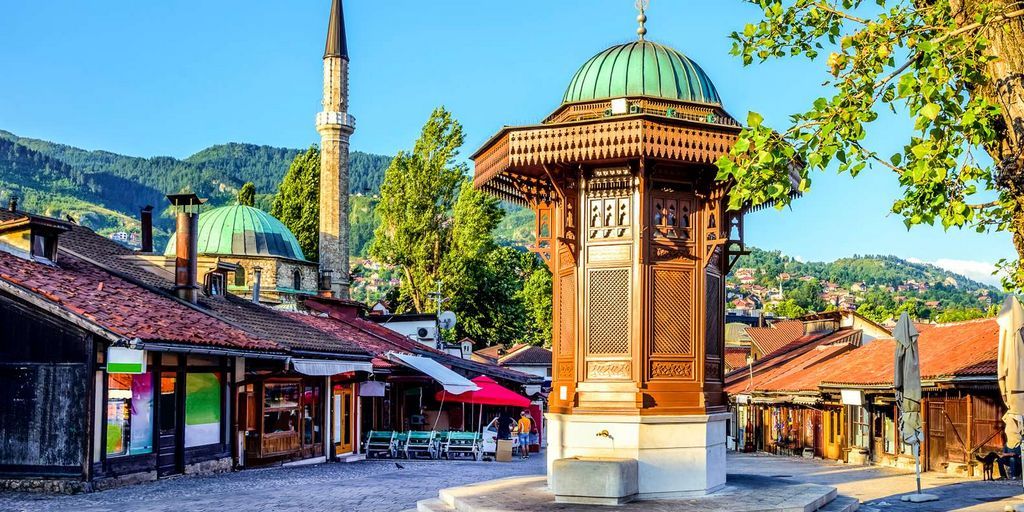Overwhelmed, I turn around. Hadn’t I simply been going through the spruced-up Ferhadija buying road, with its Austrian-style coffee houses and Western fashion chains? And currently, with every action, I seem like I’m diving into a different cosmos.
The fete has controlled the old town since Ottoman policy. The sweet smell of shisha tobacco fills the air, steaming coffee is lugged past me on luxuriant copper trays, and the muezzin requires prayer. Virtually every trade still fits in the network of alleys and yards.
At the threshold between the city center and the old town, two globes fulfill, yet this is absolutely nothing uncommon in the capital of Bosnia-Herzegovina (www.sarajevo.travel ), since below societies and faiths, periods and architectural styles as well as battle and tranquility fulfill on nearly every edge.
What to see in Sarajevo
In the old town area alone, 4 faiths are represented with churches – special in Europe. The Roman Catholic Sacred Heart Sanctuary stands at the entry gate. The heart of Bascarsija is the Gazi Husrev-Beg Mosque, whose namesake is put to rest in a tiny mausoleum next door (Sarači).
To this particular day, he is considered the daddy of the city, having actually shaped it via cultural openness and good deeds as early as the 16th century. Simply a few steps away, protected by dense trees, stands the old Sephardic synagogue, which today houses the Velika Avlija Museum, which informs the story of the Jews in Sarajevo.
The old Orthodox church on the north side of the Old Town is similarly simple.read about it https://furaj.ba/sarajevo-hostel-franz-ferdinand-2/ from Our Articles Multicultural and forgiving Sarajevo lost its innocence during the battle years in between 1992 and 1995. My sensation that people have actually shut this dark chapter lingers up until I seem like I’m standing in a swimming pool of blood at the Gradska tržnica market hall (Mula Mustafe Basceskije 4 a).
Wherever many individuals lost their lives in explosive attacks, the harmed concrete was not eliminated however dipped in red paint. Stumbling blocks, known as ‘roses,’ were positioned there.
The Galerija 11/07/95 Gallery likewise sees itself as a stumbling block. It lies discreetly in the darkness of the basilica and take care of the Srebrenica carnage, and especially its repercussions. Basic yet deeply moving photos, a number of brief movies, and an audio guide describe the nationwide injury (Trg Fra Grge Martića 2).
As the pressure of the old town spits me out once again, I locate myself standing in front of the mighty Vijećnica. The bulky, naturally embellished old town hall, integrated in 1894, is one of the most important structures in the pseudo-Moorish design. It achieved prestige twice: in 1914 during the assassination effort on Franz Ferdinand and his partner Sophie, which activated the First World War. In 1992, it was itself so badly damaged that its reconstruction wasn’t completed until 2014.
Why the scars of war were hidden here of all places becomes clear in the entrance hall: the sunlight refracts in the glass, flower-decorated dome and allows the elaborately crafted ornaments and embellished columns shine (Zmaja od Bosne 8 b).
Right outside the door is the Ottoman Light Bridge, which leads over the Miljacka River into an additional globe. Possibly the one that a lot of closely mirrors modern-day life: South of the river, residential structures and tiny shops hold on to the incline of the neighborhood hill, Trebević. Steep roads and alleys wind upwards until they give way to fields, forests, and a walkway that causes the 1984 Olympic Bobsleigh Track 3.
For almost two kilometers, it runs through the forest on the hill plateau. I follow the graffiti-decorated network to the starting point, which intersects a prominent treking trail to the Trebević lookout factor. Mounted by the carefully moving tops of the Dinaric Mountains, the futuristic Avaz Spin Tower notes the brand-new Marijin Dvor business and government district to the west.
Like a historic counterpoint, the yellow bastion of Žuta Tabija overlook the old town. From up right here, one can only think that this valley is home to greater than simply building contrasts.
The very best locations to consume in Sarajevo
Buregdžinica cavity makes the best puff pastry snails loaded with spinach, cheese, or meat. The cast-iron baking pans leave the stone oven almost every min (Mali Bravadžiluk 2). Bosnian pastas in sour lotion, cevapcici, or the meat stew muckalica are served at the waterfront dining establishment Inat kuća (Veliki Alifakovac 1).
The small Klopa, with its open kitchen and ventilated wood inside, is located in a back courtyard of Ferhadija. The menu also caters to vegetarians and allergic reaction patients (Ferhadija 5).
The Barhana bar offers food and rakija (a Bosnian fruit brandy) until the early hours on two floorings. Rakija is offered here in 25 various varieties. Walnut and honey (Đulagina čikma 8) is particularly scrumptious.
Holiday accommodation in Sarajevo
Located in a peaceful side street, the shop hostel Franz Ferdinand occupies a flooring of an old building with urban-style dormitories and personal spaces (Jelića 4; dormitory from euro10.90, double from euro15.90).
A view of the basilica, a huge terrace, and an Airbnb host who promptly ends up being a close friend: Adna is an architect with an enthusiasm for upgrading old furnishings. In her Chic Woody Home, visitors can stay in her jobs (euro50 per night).
The Hotel Europe appreciates a stunning area between the Old Town and Miljacka. Some areas supply sights of all four churches. Features consist of a medical spa and the elegant ‘Viennese Cafe’ (Vladislava Skarića 5; double areas from euro133).
Arrival
Lufthansa flies straight from Munich, Eurowings from Cologne/Bonn and Stuttgart. Austrian Airlines gets in touch with a transfer in Vienna.

